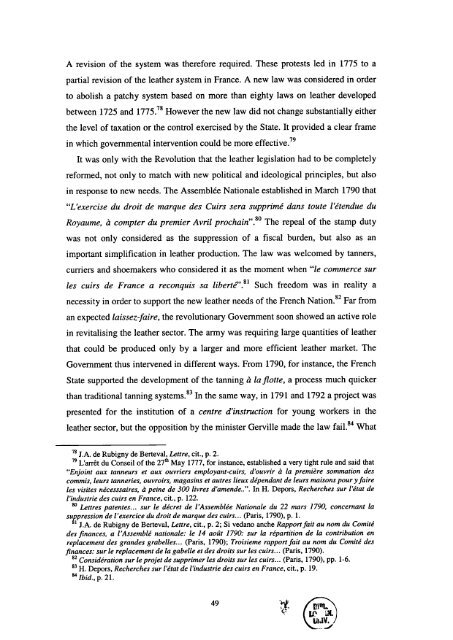The Boot and Shoe Trades in London and Paris in the Long Eighteenth Century
The Boot and Shoe Trades in London and Paris in the Long Eighteenth Century
The Boot and Shoe Trades in London and Paris in the Long Eighteenth Century
Create successful ePaper yourself
Turn your PDF publications into a flip-book with our unique Google optimized e-Paper software.
A revision of <strong>the</strong> system was <strong>the</strong>refore required. <strong>The</strong>se protests led <strong>in</strong> 1775 to a<br />
partial revision of <strong>the</strong> lea<strong>the</strong>r system <strong>in</strong> France. A new law was considered <strong>in</strong> order<br />
to abolish a patchy system based on more than eighty laws on lea<strong>the</strong>r developed<br />
between 1725 <strong>and</strong> 1775.78 However <strong>the</strong> new law did not change substantially ei<strong>the</strong>r<br />
<strong>the</strong> level of taxation or <strong>the</strong> control exercised by <strong>the</strong> State. It provided a clear frame<br />
<strong>in</strong> which governmental <strong>in</strong>tervention could be more effective.79<br />
It was only with <strong>the</strong> Revolution that <strong>the</strong> lea<strong>the</strong>r legislation had to be completely<br />
reformed, not only to match with new political <strong>and</strong> ideological pr<strong>in</strong>ciples, but also<br />
<strong>in</strong> response to new needs. <strong>The</strong> Assemblée Nationale established <strong>in</strong> March 1790 that<br />
"L'exercise du droit de marque des Cuirs sera supprimé dans toute l'étendue du<br />
Royaume, a compter du premier Avril procha<strong>in</strong>". 8° <strong>The</strong> repeal of <strong>the</strong> stamp duty<br />
was not only considered as <strong>the</strong> suppression of a fiscal burden, but also as an<br />
important simplification <strong>in</strong> lea<strong>the</strong>r production. <strong>The</strong> law was welcomed by tanners,<br />
curriers <strong>and</strong> shoemakers who considered it as <strong>the</strong> moment when "le commerce sur<br />
les cuirs de France a reconquis sa liberté". 8' Such freedom was <strong>in</strong> reality a<br />
necessity <strong>in</strong> order to support <strong>the</strong> new lea<strong>the</strong>r needs of <strong>the</strong> French Nation. 82 Far from<br />
an expected laissez-faire, <strong>the</strong> revolutionary Government soon showed an active role<br />
<strong>in</strong> revitalis<strong>in</strong>g <strong>the</strong> lea<strong>the</strong>r sector. <strong>The</strong> army was requir<strong>in</strong>g large quantities of lea<strong>the</strong>r<br />
that could be produced only by a larger <strong>and</strong> more efficient lea<strong>the</strong>r market. <strong>The</strong><br />
Government thus <strong>in</strong>tervened <strong>in</strong> different ways. From 1790, for <strong>in</strong>stance, <strong>the</strong> French<br />
State supported <strong>the</strong> development of <strong>the</strong> tann<strong>in</strong>g a la flotte, a process much quicker<br />
than traditional tann<strong>in</strong>g systems. 83 In <strong>the</strong> same way, <strong>in</strong> 1791 <strong>and</strong> 1792 a project was<br />
presented for <strong>the</strong> <strong>in</strong>stitution of a centre d'<strong>in</strong>struction for young workers <strong>in</strong> <strong>the</strong><br />
lea<strong>the</strong>r sector, but <strong>the</strong> opposition by <strong>the</strong> m<strong>in</strong>ister Gerville made <strong>the</strong> law fail. 84 What<br />
78 J.A. de Rubigny de Berteval, Lettre, cit., p. 2.<br />
L'arrêt du Conseil of <strong>the</strong> 27th May 1777, for <strong>in</strong>stance, established a very tight rule <strong>and</strong> said that<br />
"Enjo<strong>in</strong>t aux tanneurs et aux ouvriers employant-cuirs, d'ouvrir a Ia premiere sommation des<br />
commis, leurs tanneries, ouvroirs, magas<strong>in</strong>s et autres lieux dépendant de leurs maisons pour yfaire<br />
les visites nécesssaires, a pe<strong>in</strong>e de 300 livres d'amende..". In H. Depors, Recherches sur l'état de<br />
l'<strong>in</strong>dustrie des cuirs en France, cit., p. 122.<br />
80 Lettres patentes... sur le décret de l'Assemblée Nationale du 22 mars 1790, concernant la<br />
sufpression de l'exercice du droit de marque des cuirs... (<strong>Paris</strong>, 1790), p. 1.<br />
'J.A. de Rubigny de Berteval, Lettre, cit., p. 2; Si vedano anche Rapport fait au nom du Comité<br />
des f<strong>in</strong>ances, a l'Assemblé nationale: le 14 aoât 1790: sur Ia repartition de la contribution en<br />
replacement des gr<strong>and</strong>es grabelles... (<strong>Paris</strong>, 1790); Troisieme rapport fait au nom du Comité des<br />
f<strong>in</strong>ances: sur le replacement de la gabelle et des droits sur les cuirs... (<strong>Paris</strong>, 1790).<br />
82 Consideration sur le projet de supprimer les droits sur les cuirs... (<strong>Paris</strong>, 1790), pp. 1-6.<br />
83 H. Depors, Recherches sur l'état de l'<strong>in</strong>dustrie des cuirs en France, cit., p. 19.<br />
Ibid.,p.21.<br />
49<br />
(Le2L


